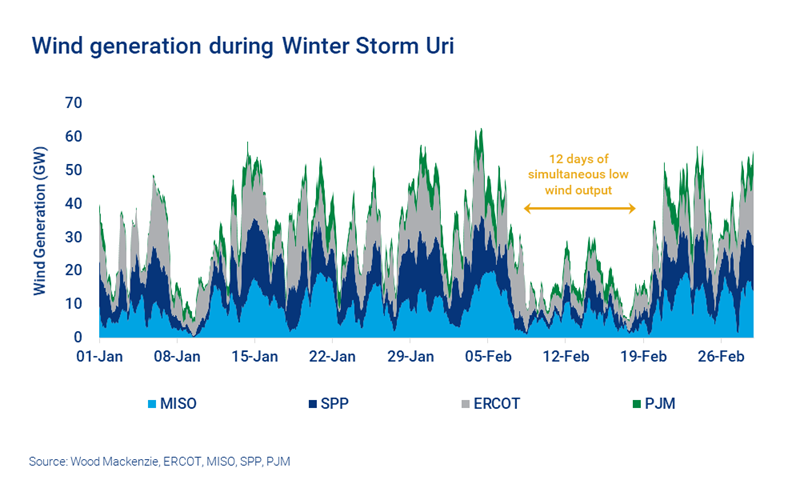Winter reliability and the road to net zero
Is winter the new summer for US power grid planning?
Ryan Sweezey
Director, North America Power & Renewables

Ryan Sweezey
Director, North America Power & Renewables
Ryan focuses on coverage of North America power markets, producing forecasts of power, capacity and REC prices.
Latest articles by Ryan
-
Opinion
2025 global power market outlook: divergent paths in a transforming energy landscape
-
Opinion
The 2025 US power market outlook
-
Opinion
The global power market outlook: can global power generation keep up with the energy transition?
-
Opinion
North American power markets: navigating a trickier path to decarbonisation
-
Opinion
The Inflation Reduction Act and its impact so far
-
Opinion
The Inflation Reduction Act one year on
Winter Storm Uri wreaked havoc on electric and gas systems unprepared for the challenge. The root causes of the power system failure in Texas have been explored in detail – but what are the implications for ensuring reliable electric supply as the energy transition progresses?
Our insight, Winter Storm Uri reveals an emerging winter reliability challenge for the energy transition, examines this in detail. Fill in the form for a complimentary extract with sample charts, or read on for an introduction.
Winter is the new summer
For about 90% of the US, the historical focus of power system reliability was during summer months, driven by air conditioning demand. Utilities typically planned for the expected gross peak demand hour each year. However, in recent years, markets with significant renewable penetration have become concerned with meeting peak ‘net load’ (gross load minus intermittent renewable generation). Net load is a critical measure because it represents the share of demand that must be served by non-intermittent resources.
In our latest long-term outlook, we project peak net load will shift to winter in all US markets prior to 2050. There are a few key reasons for this shift:
- Growing solar generation will cut into summer peaks on hot, sunny days
- Heating electrification will raise winter demand
- Poor winter solar insolation – overall and at the time of peak (morning/evening)
Our forecast is based on normal weather expectations, but extreme events, like Winter Storm Uri, could accelerate this timeline. This makes adequate planning for the winter reliability shift critical.
Sustained multi-day winter wind droughts are a reliability risk
Uri brought a nearly two-week long period of sustained low wind output across the entire Central Plains. This area – covering ERCOT, MISO, SPP, and western PJM – represents nearly 50% of the continental US land mass. It also contains the bulk of the country’s wind fleet.
While the duration of this wind drought may be unprecedented in its impact, the drought itself is by no means unprecedented. Artic fronts typically bring high pressure and low wind speeds in their wake. For example, the same Central Plains footprint endured six days of sustained low wind output in late November 2015. The Northeast US frequently experiences sustained wind droughts, including one lasting five days in late January 2020. Offshore wind is not immune: Northern European offshore wind output experienced a twelve-day drought as recently as March 2021.
It’s important to note that winter wind droughts present a different risk than summer intermittency. The key difference is the multi-day duration of winter droughts coinciding with weather systems. As is often observed in ERCOT, summer wind production typically dips during the afternoon hours, sometimes to near zero output, but generally comes roaring back to strong production in the evening. On average, summer diurnal solar complements this profile, with short-duration battery storage – charged by surplus solar – well positioned to fill any gaps.
Flexible generation and/or long-duration storage are critical to weather future winter wind droughts
Net load across the ERCOT-MISO-SPP-PJM footprint ramped from a low of 164 GW days before Uri to a peak of 296 GW during the storm. A few days after the storm, net load hit a trough of 140 GW. These wild swings in net load were fulfilled with gas – which performed better outside of ERCOT – and coal generation. Coal generation across the ERCOT-MISO-SPP-PJM footprint returned to baseload levels for two weeks. Coal even exceeded gas generation during the heart of the storm.
Clearly, flexible firm generation and generation that can sustain for multi-day periods are needed during winter extreme events. What technologies will fill these roles in a decarbonized future?
Clearly, flexible firm generation and generation that can sustain for multi-day periods are needed during winter extreme events.

Ryan Sweezey
Director, North America Power & Renewables
Ryan focuses on coverage of North America power markets, producing forecasts of power, capacity and REC prices.
Latest articles by Ryan
-
Opinion
2025 global power market outlook: divergent paths in a transforming energy landscape
-
Opinion
The 2025 US power market outlook
-
Opinion
The global power market outlook: can global power generation keep up with the energy transition?
-
Opinion
North American power markets: navigating a trickier path to decarbonisation
-
Opinion
The Inflation Reduction Act and its impact so far
-
Opinion
The Inflation Reduction Act one year on
Our analysis of a potential similar event in 2050 indicates a storage duration need of at least one week, even with 25% of demand served by unspecified non-intermittent generation. Current lithium-ion durations of 2-4 hours are wholly inadequate to this task. Several long-duration technologies are in development – see Form Energy’s pilot project – but the technology has a long way to scale.
Hydrogen likely has an important role to play as both flexible generation and long-duration storage, but there are still challenges to overcome prior to widespread adoption.
Additional transmission interconnection alone would not have saved ERCOT
In the wake of Uri, some suggested that increasing ERCOT’s limited interconnection with other markets would have mitigated blackouts. This ignores the broad geographic reach of the storm. Supply was very tight or inadequate to meet record demand across a huge geographic area. For example, MISO and SPP both reached Energy Emergency Alert Level Three and instituted rolling blackouts. Eastern portions of the Western Interconnect also strained to balance supply and demand.
Increasing interconnection between ERCOT and these regions would not have solved the supply constraints within the neighboring regions. Excess power would be limited or unavailable even if additional interconnections existed. That said, existing transmission played a critical role during Uri: PJM exported a record high of 15.7 GW of power which flowed to MISO and SPP. However, given the huge geographic footprint of Uri, transmission expansion would need to be continental in nature to access supply beyond Uri’s reach. This type of expansion is well beyond proposals to simply interconnect ERCOT with other regions with a few HVDC interconnectors.
Market designs will need to evolve to support winter reliability
Markets are generally designed around ensuring summer reliability; every US regional transmission operator is currently summer peaking. Capacity markets and resource adequacy processes both focus on meeting summer peaks, although PJM and ISO-NE adopted capacity market rules to incentivize winter performance in recent years. Summer reliability risk is greatest in a small subset of peak load hours, and market designs generally consider typical renewable intermittency in these hours.
Winter poses a different challenge: sustained multi-day periods of low wind, low seasonal solar output, and/or solar output not aligned with peak demand. Storage durations will need to be weeks – not hours – to fill the gap when sustained wind droughts occur. Even if long-duration storage were technically viable today, markets have no mechanism to incentivize and compensate long-duration storage.
These mechanisms must be thoughtfully developed to bring long-duration storage to scale. Doing so may just prove the key to keeping the lights on in winter as the energy transition moves forward.
Explore this topic in more detail
To find out more, fill in the form for an extract from the full report, which includes charts on:
- Winter Storm Uri: observed weather and load
- Wind droughts in recent years
- Transmission flows during the storm
- ERCOT as a ‘summer-peaking’ system







